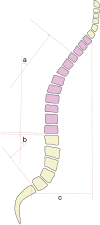A review of cervical spine alignment in the normal and degenerative spine
- PMID: 32309650
- PMCID: PMC7154373
- DOI: 10.21037/jss.2020.01.10
A review of cervical spine alignment in the normal and degenerative spine
Abstract
With recent advancements in surgical spine technology and techniques, the importance of regional and global spine alignment has become an important factor in surgical planning. Our review aims to consolidate the current literature on cervical and global alignment parameters and its relationship to cervical symptomatology, quality of life (QOL), requirements for surgery, potential surgical complications and health-related quality of life (HRQOL) outcomes.
Keywords: Quality of life (QOL); cervical; complications; global alignment; spine alignment.
2020 Journal of Spine Surgery. All rights reserved.
Conflict of interest statement
Conflicts of Interest: The series “Advanced Techniques in Complex Cervical Spine Surgery” was commissioned by the editorial office without any funding or sponsorship. The authors have no conflicts of interest to declare.
Figures








References
-
- Dubousset J. Three-dimensional analysis of the scoliotic deformity. Pediatr Spine Princ Pract 1994.
-
- Ganau M, Zewude R, Fehlings MG. Functional anatomy of the spinal cord. In: Kaiser MG, Haid RW, Shaffrey CI, et al. editors. Degenerative cervical myelopathy and radiculopathy. Cham: Springer International Publishing, 2019:3-12.
Publication types
LinkOut - more resources
Full Text Sources
